Aklilu Toma Shamenna, Ashenafi Senbeta Bedane, Anteneh Bezabih Ali
College of Natural and Computational Sciences, Hawassa University, Hawassa, Ethiopia
Correspondence to: Aklilu Toma Shamenna, College of Natural and Computational Sciences, Hawassa University, Hawassa, Ethiopia.
| Email: |  |
Copyright © 2020 The Author(s). Published by Scientific & Academic Publishing.
This work is licensed under the Creative Commons Attribution International License (CC BY).
http://creativecommons.org/licenses/by/4.0/

Abstract
In 2011, only 7 per cent of Ethiopian children under 5 years old were registered at birth. With no proof of age or identity, children do not have the minimal protection needed against child marriage, child labor, trafficking or detention and prosecution as an adult. The absence of a legal framework for a national vital events registration and vital statistics system has resulted in unconventional and uncoordinated practices of producing civil status evidence, such as the issuance of birth, death and marriage certificates by hospitals, churches and municipalities. This research is intended to assess resident’s knowledge, attitude and practice toward vital statistics and civil registration in Hawassa City Admiration, Ethiopia. Stratified random sampling techniques were applied and a sample was selected based on single stage stratified sampling design. All sub cities under Hawassa city administration were stratified as into 12 clusters based on CSA 2007 population and housing census of Ethiopia and a total of 377 households were included in the study. Among the respondents included in the survey, 24.6% of them had registered for vital events of their family. The study also revealed that the most common reasons for not being registered for vital events are the long-time taken to take service at kebeles (56.5%), long distance to registration office (48.5%), high registration cost (44.0%), lack of awareness on vital events registration (27.1%) and lack of information on vital events registration (28.6%). Furthermore, the result of correlation specified that, there is a significant positive relation between household attitude and practice on vital event registration. Concerned government body should take in to account this gap and promote usefulness of vital events registration to the public.
Keywords:
Civil Registration, Vital Events, Attitude, Ethiopia
Cite this paper: Aklilu Toma Shamenna, Ashenafi Senbeta Bedane, Anteneh Bezabih Ali, Assessing Knowledge, Attitude and Practice of Residents towards Civil Registration & Vital Statistics at Hawassa City Administration and Its Neighbourhoods, SNNPRS, Ethiopia, International Journal of Advanced and Multidisciplinary Social Science, Vol. 6 No. 1, 2020, pp. 13-27. doi: 10.5923/j.jamss.20200601.02.
1. Introduction
Civil registration and vital statistics systems are concerned with the legal registration and analysis of vital events in the population. Vital events include births, deaths, marriages, divorces, fetal deaths, annulments, judicial separations and adoptions, and through the registration process these events are made legal and legitimate (WHO, 2013).CRVS is critical for women and children. The Global Strategy for Women's, Children's and Adolescents Health 2016-2030 calls for expansion of civil registration and vital statistics systems to increase access to services and entitlements; in order for women and children to realize their rights to proper health care, education and basic social benefits, including housing and social protection. CRVS systems are also critical to the 2030 development goals across the life-course, with 15 of the 17 Sustainable Development Goals using indicators which require high quality CRVS data. For countries, a fully functioning CRVS system also generates important information which is a prerequisite to socioeconomic planning and informed decision-making, enabling governments to monitor key demographic and health indicators, including infant, child and maternal, and adult mortality, and target resources and interventions by geography and population group (WHO, 2018).Nowadays the demand for reliable and quality demographic information has become key concern of all. In most of the developing countries, the lack of reliable and current socio-economic data, specifically at the lower administrations levels is impeding the proper execution and monitoring of development endeavours. Monitoring and evaluation of the effect /impact of policy changes and intervention programs is possible only with the availability data that reflect the status or activities of the sectors under consideration. One of the sources of this type of information is Vital Statistics. The sources of Vital Statistics are vital record from CRVS, specific questions in population census and in sample surveys, vital records from sample registration areas, records from health services and administrative records (T. G. Birru, 2007).The importance of civil registration and vital registration system for legal, administrative and statistical purposes is getting recognition by the judicial bodies, policy makers and planners in Ethiopia. Unfortunately, in Ethiopia, there is a wide gap between what is needed and what is available especially in gender statistics (T. G. Birru, 2007). We would all agree that a civil registration and vital statistics system is an integral part of the regular and routine governance of a country and it is primarily the responsibility of the government to ensure that the necessary resources are in place to run it smoothly and efficiently (UNECA, 2014).Emphasis is being placed on achieving measurable results on the ground, on evidence-based planning and on mechanisms for monitoring and evaluating development results. Vital registration system has a very poor performance in all the sub-Saharan African countries. The most accurate vital statistics are found in countries that are in an advanced stage of economic development. One of the key issues that have kept the sub-Saharan African countries in the state of underdevelopment is the unavailability of accurate statistical data for social and economic planning purposes. Recently the application of computer technology to administrative and operational activities has received major attention in the world. Many African countries are experiencing the demand of increasing on the vital registration activities (Adedini S. A & Odimegwu C. O., 2011).Generally this study was intended to assess resident’s knowledge, attitude and practice toward vital statistics and civil registration in sub cities of Hawassa City Administration, SNNPRS, Ethiopia.
1.1. Statement of the Problem
Countries need to know how many people are born and die each year and the main causes of their deaths in order to have well-functioning health systems. The only way to count everyone and to track all births and deaths is through civil registration. Civil registration provides the basis for individual legal identity but also allows countries to identify their most pressing health issues. Globally, two-thirds (38 million) of 56 million annual deaths are still not registered and every year, almost half of the world’s children go unregistered. When deaths go uncounted and the causes of death are not documented, governments cannot design effective public health policies or measure their impact. Civil registration is something that all developed countries has, and that developing countries need (WHO, 2014).Civil registration system has a very poor performance in all the sub-Saharan African countries. The most accurate vital statistics are found in countries that are in an advanced stage of economic development. One of the key issues that have kept the sub-Saharan African countries in the state of underdevelopment is the unavailability of accurate statistical data for social and economic planning purposes (Adedini S. A & Odimegwu C. O., 2011). Having this background, our study aims to examine the knowledge, attitude and practice of vital registration system in Hawassa City Administration, Ethiopia.
1.2. Significance of Vital Events Registration
Comprehensive, permanent and continuous vital events registration and vital statistics systems provide a great number of significant benefits to the individual; to the nation; and to the international community. For individuals copies of registration records provide legal documents for identity, origin, date of birth, marriage or death. Registration records also provide information on the vital events, which serve important administrative and statistical purposes (UN, 1998).
1.2.1. Legal Uses
Individuals use copies of registration records to provide legal proof of identity, origin, marriage or death. For instance, civil registration records of birth provide legal proof of identity and civil status, including name, date and place of birth, parentage, citizenship, nationality and legitimacy status. These in turn affect a wide variety of rights to which an individual may be entitled, especially those depending on age, citizenship or ancestry for inheritance, social and other purposes. Birth records can also help determine rights to insurance benefits, child custody and tax deductions. Similarly, death records provide legal evidence relevant to claims to inheritance, property, insurance benefits and the legal right of a spouse to remarry. Marriage and divorce records are essential records for family rights protection, establishing entitlements for inheritance rights, alimony and the right to remarry (UN, 1998).
1.2.2. Administrative Uses
Vital events records of individuals serve many administrative and governmental purposes. Such information is valuable to the electoral system, by providing accurate up-to-date lists of persons qualified to vote at various electoral levels, such as at the regional level, wereda and kebele levels. It contributes to the accuracy of the electoral rolls, and to the efficient organization and monitoring of elections. For instance, lists of deaths can be used to purge voter registration rolls. Marriage records can be used for establishing tax deductions, proving the right to alimony in the event of divorce and establishing claim to property in the event of a partner's death. Many countries use civil registration information as the basis for a national identification system of the citizens (CSA, 2013).
1.2.3. Statistical Uses
Civil registration, and the vital statistics derived from this system, provides a broad and comprehensive information base for the population of a country. Programs that involve population dynamics, the health status of the population, and the protection of family rights and well-being of children benefit from a vital events registration system. For the nation, effective registration and vital statistics systems provide essential data, rates and other quantitative measures for the accurate planning of programs designed to promote the well-being of the citizens. The data collected from vital events registration are essential to planning for social development, including the design and implementation of public health measures, maternal and child care, family planning, social security, education, housing and economic development. At the local level, accurate information is essential for proper planning for the needs of the community, particularly for health and education facilities, as well as for housing and the labor market (Mills et al., 2019). Accurate and comprehensive vital statistics generated from civil registration provide for comparison and evaluation of differences among regions, between zones and districtss within a region, and at the international level between countries.
1.2.4. Health Statistics
Death records are of particular importance in public health, for identifying the magnitude and distribution of major disease problems. Data from these records can be used for epidemiological studies. Cause of death information is essential for medical research into such major causes of death as cancer and heart disease (R. Rampatige et al., 2014).
2. Literature Review
2.1. Concepts and Definitions of Terms Used in the Document
This section provides international concepts and definitions of important terms used in the document in relation to vital events registration and the collection, production and dissemination of vital statistics.
2.1.1. Vital Events
The United Nations recommends that countries should register and collect information on the following vital events for civil registration and vital statistics purposes: birth; death; fetal death; marriage; divorce; annulment; judicial separation; adoption; legitimation (acknowledgement); and recognition (judicial declarations of paternity) (UN, 2001). The top priority vital events to be recorded are births, marriages, divorces and deaths. Not every country records all vital events recommended by the UN, although it remains to be the eventual goal. Therefore, to facilitate the establishment of the vital events registration system, priority is assigned to the list of vital events.The 2012 law assigns an order of registration priority by selecting most of the internationally recommended vital events and by dropping some which were considered less important for the time being.The international recommended definitions for these vital events as given by the United Nations (UN, 2001), along with the definitions of these events in the Ethiopian context, if available, are given below. It should be noted that although the United Nations definitions were given for statistical purpose, civil registration offices around the world have adopted it for their purposes.SRS could potentially be applied in a country such as Kenya, which has an established civil registration data collection system but no systematic collection of the statistics (Mbuvi B., 2003).Two large countries China and India, have established Sample Registration Systems that provide useful data at national level (Yang G et al., 1992).Related studies and surveys indicate that data concerning unregistered children are approximate. Most unregistered children are found in developing nations and even within a country, children born in rural and remote areas and children born of parents, who are marginalized because of ethnicity and poverty, are more likely not to be registered. Even in industrialized countries where the rate of registration is as high as 98%, birth registration cannot be claimed as a universal human right (UNICEF, 2013).According to (UNICEF, 2005), South Asia has the largest number of unregistered children with 63% of births unrecorded. In Sub-Saharan Africa, 55% of all births go unregistered followed by central and eastern Europe, the Commonwealth of Independent States and the Baltic States where 23 per cent of children are not legally recognized. In East Asia and the Pacific, 19% of births are not registered and in the Middle East and North Africa this figures stands at 16%, 15% of children are not registered at birth in Latin America and the Caribbean and, finally, 2% of children in industrialized countries are ‘invisible’.Live Birth is the complete expulsion or extraction from its mother of a product of conception, irrespective of the duration of pregnancy, which after such separation, breathes or shows any other evidence of life, such as beating of the heart, pulsation of the umbilical cord or definite movement of voluntary muscles, whether or not the umbilical cord has been cut or the placenta is attached; each product of such a birth is considered live born (all live-born infants should be registered and counted as such, irrespective of gestational age or whether alive or dead at the time of registration, and if they die at any time following birth they should also be registered and counted as deaths) (WHO, 2004).In the Ethiopian context, Article 4(1) of the 1960 Civil Code states that:1. A child shall be deemed to be viable where he lives for forty-eight hours after his birth, notwithstanding any proof to the contrary.2. A child shall be deemed to be not viable where he dies less than forty-eight hours after his birth.3. The presumption laid down in sub-article (2) may be rebutted by proving the death of the child is due to a cause other than a deficiency in his constitution (Imperial Ethiopian Government, 1960).There is obviously a great divergence between the national and international definition of live birth, which needs to be addressed according to (U.S. Bureau of the Census, 1971). Death is the permanent disappearance of all evidence of life at any time after live birth has taken place (postnatal cessation of vital functions without capability of resuscitation). This definition excludes fatal death. Marriage is the act, ceremony or process by which the legal relationship of husband and wife is constituted. The legality of the union may be established by civil, religious or other means as recognized by the laws of each country. Divorce is a final legal dissolution of a marriage, that is, that separation of husband and wife which confers on the parties the right to remarriage under, religious and/or other provisions, according to the laws of each country.
2.1.2. Vital Events Registration
The United Nations defines vital events or civil registration as “the continuous, permanent, compulsory and universal recording of the occurrence and characteristics of vital events pertaining to the population as provided through decree or regulation in accordance with the legal requirements in each country” (UN, 2001).
2.2. Civil Registration and Vital Statistics in Ethiopia
Provisions for the registration of vital events were included in the Ethiopian Civil Code enacted in 1960 (Imperial Ethiopian Government, 1960). The 1960 Civil Code made it compulsory to register births, deaths and marriages. However, Article 3361 of the same 1960 Civil Code prohibited those articles pertaining to civil registrations coming into force until an official order was issued. The order to activate these articles never came. Thus, for several decades, municipalities of big cities and cities had been issuing certificates of births, deaths, marriages and divorces without proper registration anchored in a national law. In 2000, the Revised Family Law (The Revised Family Code Proclamation, 2000) was enacted. It had incorporated provisions for the registration of marriages and births. It also requested the Federal Government to issue registration law that would establish the Office of Civil Status.In August 2012, the Federal Democratic Republic of Ethiopia (FDRE) issued the Registration of Vital Events and National Identity Card Proclamation No. 760/2012, referred hereafter as the 2012 law, which is a comprehensive and compulsory law on registrations of vital events in Ethiopia (Federal Negarit Gazeta, 2012). This law repealed Articles 47 to 153 of the 1960 Civil Code, which were provisions on civil registration that had been suspended indefinitely and therefore never put to any use. A vital events registration system, which is comprehensive, continuous, and compulsory, is the main source vital statistics. As mentioned above, this system did not exist in Ethiopia because the 1960 Civil Code on vital events registration was not functional. Other administrative records in the country are not well developed to be of use for statistical purpose. In the absence of an active law which made registration mandatory, the Central Statistical Agency (CSA) resorted to collecting data on vital events through population and housing censuses and household surveys. Although in an integrated program of data collection, these three sources should complement each other, in Ethiopia, population and housing censuses and household surveys remained to be the primary source of data on demographic, social and economic matters, and on human settlements for more than five decades (CSA, 2012).CSA had conducted sample vital events registrations for statistical purposes from 1970s to early 1990s. A serious attempt to undertake a conventional civil registration based on international recommendations and guidelines were also attempted starting in the early 1990s. Several United Nations Children’s Fund (UNICEF) sponsored model projects were undertaken during this period in selected lowest administrative areas of Tigray, Amhara and the State of the Southern Nations, Nationalities and Peoples (SNNP) regions of the country. The main weakness of this undertaking was the lack of a comprehensive legal framework which could have made registration compulsory. However, the experience and insight obtained from the model projects were useful, particularly the design and testing of registers and forms, various handbooks and guidelines. These tools and documents would need minimal revisions and updating during the preparation for the establishment of the comprehensive vital events registration system (ACS & ECA, 2017).
3. Methods and Materials
3.1. Description of the Study Area and Population
The study was conducted in south nation’s nationalities and People’s Republic of Ethiopia, Hawassa city and surrounding which is one of the districtss in the Southern Nations, Nationalities and Peoples Region of Ethiopia. Part of the Sidama Zone located in Great Rift Valley. Hawassa city is bordered on the South by Shebedino and Boricha, on the West and North by the Oromia Region, and on the East by Wondo Genet. The forest cover in the area partly covered by these districts has decreased from 48,924 hectares in 1972 to an estimated 8600 in 2000.Based on the 2007 Census conducted by the CSA, this districts has a total population of 124, 472 of whom 62,774 are men and 61,698 women; none of it population are urban dwellers (CSA, 2012). The topography of Hawassa and Surrounding districts is located in the south land and south north of the area and it is characterized by mountain, hills & escarpment and narrow valley. Most of the area land has loop between 20%-100% which resulted massive soil erosion (rural development office report, 2008). The altitude lies between 1500-3113 mass. South east of the study area and it is characterized by gentle slope& flat land to three agro climate zone. The dega zone altitude lies between 2300- 3200mass. The rain fall is between 1000-2000mm & the mean temperature is by cereal production and they are mainly department on rain water. The substantial amount of land are cultivated and overgrazed. As a result of this, depredate of soil is common in the area is characterized by an altitude of 1600-2400mass, the rain fall ranges 900-1300 mm and it embodied 48 kebeles and has four growing seasons: spring, autumn, summer and winter.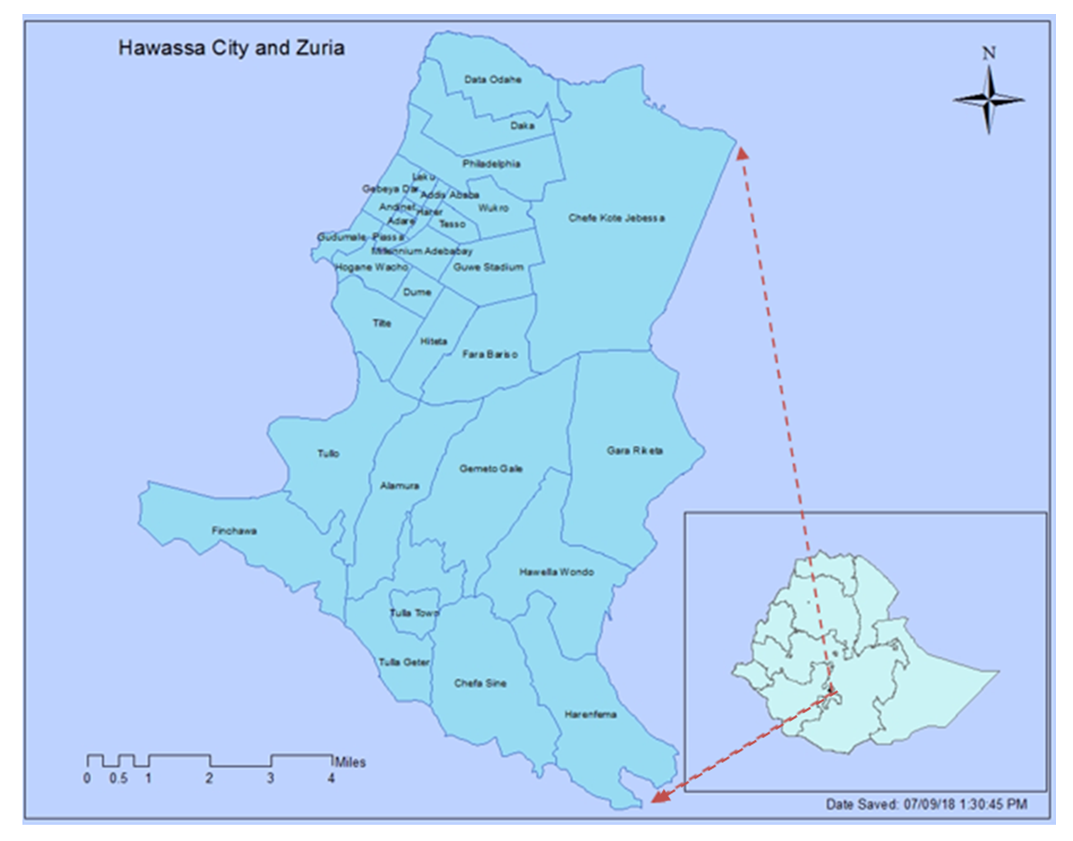 | Figure 1. Topography of the Study Area |
3.2. Data Collection Methods
The study was intended to study the knowledge, attitude and practice of the residents on vital registration. Well-structured questionnaire was designed to gather data from the respondents. A target sample size of 370 respondents was randomly selected using a multi-stage random sampling technique (Cochran, 1977). Based on this, a cross-sectional data was collected from April 10 to April 25, 2019.
3.3. Sample Design and Selection
The sample is stratified and was selected based on single stage stratified sampling design. Hawassa city and its surrounding districts were stratified as into 12 cluster based on 2007 population and housing census of Ethiopia (CSA, 2012). The stratification was given as follows: Dato Adane, Chefe Kote Jabesa, Gara Riketa, Gemeto Gale, Alamura, Tulo, Finchewa, Tula Rural, Chefa Sine, Abela Wondo and Haremfuma. Samples of households were selected independently in each stratum in single stages sampling design. Implicit stratification and proportional allocation were achieved at each of the lower administrative levels.The cluster size is the number of residential households in the strata. A household listing operation was implemented in the 12 cluster of Hawassa city administration. Primary data was collected through the help of interview based on questionnaires distributed to households accordingly in each stratum. The sample size was determined based on single stage stratified sampling design. According to (Cochran, 1977) the sample households required for the current study was determined based the following formula. The total sample households required for the project was calculate as: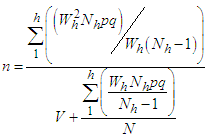 | (1) |
With  Z=1.96 for a 95% level of confidence, or 2.56 for a 99% level of confidence and d is maximum allowable (margin) error and h is the number of cluster of Hawassa city and surrounding districts. The specified variance of the estimate and in case of estimating proportion, the stratum variance is given by for common p (proportion of households having enough knowledge of civil registration and vital events). In the most case, the proportion of success is given as (p=0.5) that can be used in different literature to determine the sample size. The reason that the study used common p for all cluster was that all civil registration and vital event registration is provided at kebeles of Hawassa city and its surrounding districts was homogenous.Sampling WeightsDue to the non-proportional allocation of the sample to different clusters in Hawassa city administration with possible differences in response rates, a sampling weight must be used in all analyses using the data to ensure the actual representative of the survey. Since the single stage stratified cluster sample, sampling weights are based on sampling probabilities each cluster.The study used the following notations:
Z=1.96 for a 95% level of confidence, or 2.56 for a 99% level of confidence and d is maximum allowable (margin) error and h is the number of cluster of Hawassa city and surrounding districts. The specified variance of the estimate and in case of estimating proportion, the stratum variance is given by for common p (proportion of households having enough knowledge of civil registration and vital events). In the most case, the proportion of success is given as (p=0.5) that can be used in different literature to determine the sample size. The reason that the study used common p for all cluster was that all civil registration and vital event registration is provided at kebeles of Hawassa city and its surrounding districts was homogenous.Sampling WeightsDue to the non-proportional allocation of the sample to different clusters in Hawassa city administration with possible differences in response rates, a sampling weight must be used in all analyses using the data to ensure the actual representative of the survey. Since the single stage stratified cluster sample, sampling weights are based on sampling probabilities each cluster.The study used the following notations: | (2) |
With  , is the sample weight for hth stratum
, is the sample weight for hth stratum  is the number of households in hth strata and N is the total number of households at the study area. Table 1 below depicts the values of number of households in each stratum and their corresponding sample weight based on 2007 population and housing census of Ethiopia (CSA, 2012).
is the number of households in hth strata and N is the total number of households at the study area. Table 1 below depicts the values of number of households in each stratum and their corresponding sample weight based on 2007 population and housing census of Ethiopia (CSA, 2012). Table 1. Distribution of households across cluster of Hawassa City and Surrounding based on CSA, 2007 population and housing census of Ethiopia
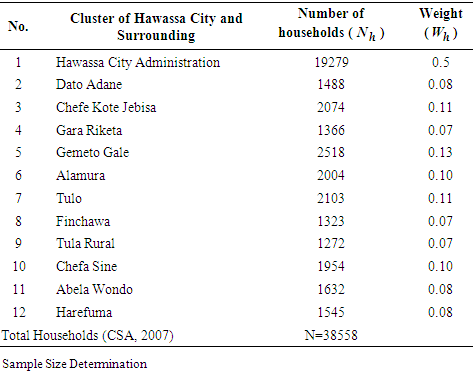 |
| |
|
The sample size for this study was determined based on stratified sampling for proportions of 95% confidence level. A total of 377 households were participated in this study and the sample size was computed based on the following formula: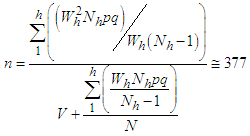 | (3) |
Proportional Allocation to cluster sizeOnce, the total sample size used in the study was determined, we can use the result to now the number of households sampled from each cluster of the study area. Accordingly, we determined the number of households participated in the study from each cluster as given below in Table 2.Table 2. Proportional Allocation to Cluster Size
 |
| |
|
3.4. Method of Data Analysis
After collecting cross-sectional data through structured questionnaire, we performed through edition of questionnaires ensure completeness and internal consistency. Then, the final edited data were captured in to statistical package for social science (SPSS) version 20.0 for descriptive analysis and correlation statistics calculations. We used p-value approach to confirm statistical significance of our findings. Moreover, Microsoft excel 2010 was used for bar chart construction. Respondents were asked whether or not they knew the official time to record the birth of new born child following delivery, marriage following its occurrence, divorce following its breakdown, and death following its occurrence. Those respondents whose answer coincides with official time frame for vital events registration were assumed to have enough knowledge on vital events and civil registration. Moreover, the level of knowledge of residents on the uses of vital event registration was assessed by using eight questions which, based on literature, are assumed to be a measure of knowledge level. Frequency and percentage for all eight questions were computed to see the level of knowledge of participants on the use of vital events registration.Similarly, nine global knowledge questions were designed to see attitude of participants towards vital events and civil registration. Their attitude was assessed based on their ratings for each questions as very useful, useful, slightly useful, not useful. Finally, to assess the practice of residents on current service provided by vital events registration office, seven possible reasons were designed to see why they remain unregistered for vital events. Frequency and percentages were computed for ‘yes’ or ‘no’ options for each of seven possible reasons.
4. Results
4.1. Respondents Demographic Characteristics
Table 3. Socio economic and demographic characteristics of respondents
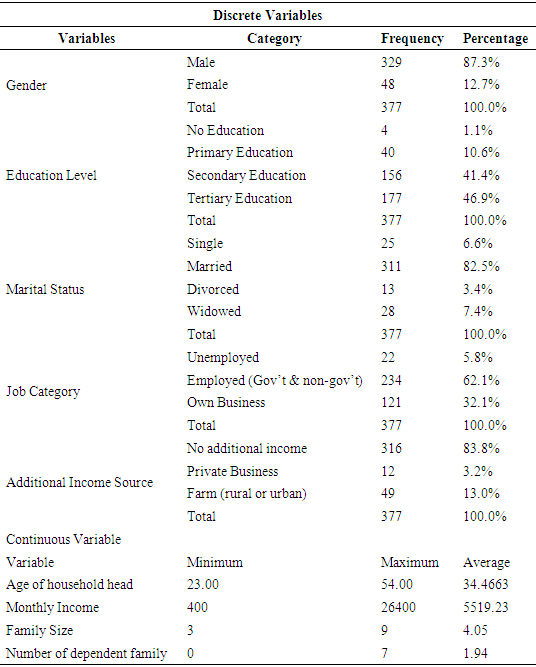 |
| |
|
The above table presents descriptive statistics of respondent’s socio economic and demographic characteristics. From the table we see that among the respondents, 87.3% are male while the remaining 12.7% are females. Regarding educational level, among the total respondents, those with no education, primary education, secondary education and tertiary education are 1.1%, 10.6%, 41.4% and 46.9% respectively. When we see the marital status of respondents, 6.6% are single, 82.5% are married, 3.4% are divorced and 7.4% are widowed. On the other hand, 62.1% are employed (both government and NGO’s), 32.1% run their own business while 5.8% of respondents are unemployed.From the table, we also see that the average age of respondents is 34.5 years with average income, family size and number of dependents family respectively equal to 5519.2 ETB, 4.05 and 1.94.
4.2. Assessment of Knowledge of Residents towards Vital Events and Civil Registration
Table 4. Results of knowledge assessment of residents towards Vital Events and Civil Registration
 |
| |
|
The above table shows the results of factors to measure the knowledge level of residents of civil registration and vital events. From the table we see that among the respondents included in the study, 86.7% heard about vital events registration by different means while 13.3% of the respondents never heard about vital events registration. Among respondents who heard about vital event registration and its contents, 62.6% heard form mass media (TV, Radio, social media etc.) for the first time while the remaining 24.1% heard about it from health centre. From the table we also see that none of respondents heard from either of Kebele level meetings, church or friends.Regarding the knowledge of respondents about the content of vital events, 87.0% (n=377) of the respondents know about the content of the four vital events, birth, marriage, divorce and death while the remaining 13.0% do not know the content of any of the four vital events.When we see respondents knowledge about the official time to record vital events, 69.5% of them know the official time to record the birth of new born child following deliverance, 64.2% of them know the official time to record the marriage following its occurrence, 68.4% of them know the official time to record the divorce following its breakdown and 72.7% of them know the official time to record the death following its occurrence.Assessing residents knowledge towards use of vital event registrationThe following table displays the results of assessing the level of Knowledge on the uses of vital event registration. We assessed this by using eight questions which measures the level of knowledge of respondents regarding the use of vital events registration.Table 5. Results of assessing the level of Knowledge on the uses of vital event registration
 |
| |
|
The results indicate that 66.6% (n=377) of them know that vital event registration is used for protection human right for citizens while 33.2% do not know that vital event registration is used for protection of human rights. It is known that vital events registration is useful in implementing rule of law and in our study we see that 75.9% of respondents know this reality while the remaining 24.1% do not know. Regarding the use of vital events registration for implementation of government policies and strategies, 71.1% of respondents know that it is useful for tracking progress of government towards implementation of health-related and education policies while the remaining 28.9% do not know that it is useful to do so.On the other hand, 75.3% (n=377) of respondents know that vital events registration are used for computation or estimation of birth and death rates while 24.7% do not know. And also among the respondents included in this survey, 70.3% of them know that vital events registration is used for ensuring vaccination coverage for children while the remaining 29.7% do not know. Lastly we see that 81.2% (n=377) of the respondents know that birth registration is useful in designing infrastructure projects based on the general behaviors of population.
4.3. Assessment of Attitude of Residents towards Vital Events and Civil Registration
Table 6. Results of assessment of attitude of residents towards vital events and civil registration
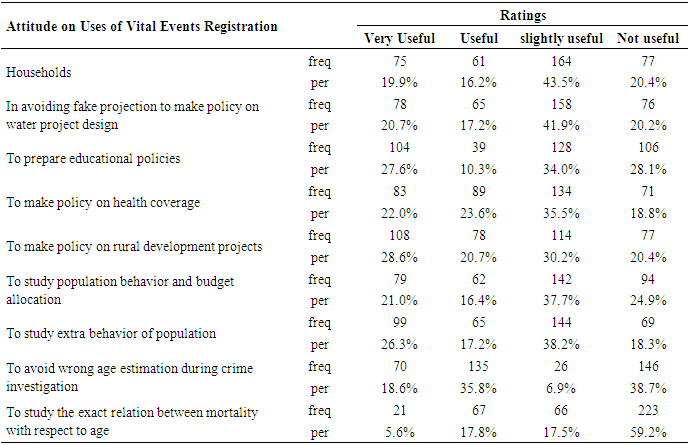 |
| |
|
We employed nine measures to assess attitude of respondents on the importance of civil registration and the results were displayed under Table 6 above. Each of the respondents was asked to give ratings for each question (measures). From the results we can see that among respondents included in this study, 20.7% of them believe that vital events registration are very useful in avoiding fake projection to make policy on water project design and 20.2% of them believe that vital events registration are not useful in avoiding fake projection to make policy on water project design. On the other hand 41.9% of the respondents believe that it is only slightly useful and 17.2% of them believe that it is useful in avoiding fake projections in making policy on water project.On the other hand we can also see that the percentages of respondents who believe that vital event registration are very useful for budget allocation according to population size and its behavior are 21.0% while 24.9% of them do not agree with this idea and 37.7% of them believe that vital event registration are only slightly useful for budget allocation according to population size and its behavior.When we see the attitude of respondents on importance of vital event registration in avoiding wrong age estimation during crime investigation, 18.6% of them believe that is very useful, 35.8% of them believe that it is useful, 6.9% of them believe that it is only slightly useful and 38.7% of respondents do not agree with the importance of vital event registration in avoiding wrong age estimation during crime investigation.Again from Table 6 we see that only 5.6% of respondents believe that vital event registration are very useful to study the exact relation between mortality with respect to age while the majority of them (59.2%) believe that vital event registration are not useful for this study. On the other hand among respondents included in the study, those who believe that vital event registration are useful and only slightly useful to study the exact relation between mortality with respect to age are 17.8% and 17.5% respectively.The below chart (Figure 2) displays household’s attitude towards vital events certification quality and number of workers at kebele office. Among the respondents who used vital events certification before, 25.55% believe that certification quality is poor while 67.35% and 7.14% of them believe that respectively that certification quality is moderate and very good respectively. On the other hand, regarding the ratio of number of workers to customers at kebele level, 28.57% of the respondents believe that the ratio is poor while 59.18% of the respondents believe that the ratio is moderate and 12.24% of the respondents believe that the ratio workers to customer ratio at kebele level is very good.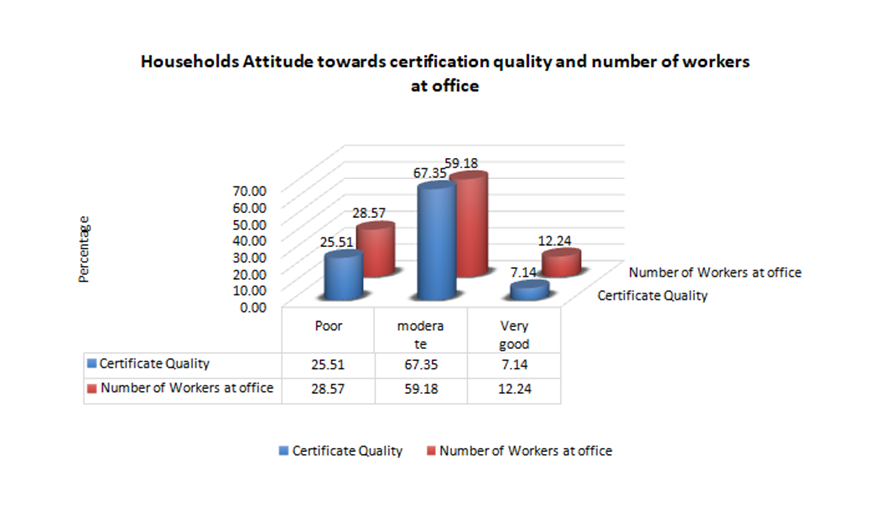 | Figure 2. Bar chart: Household attitude towards certificate quality and number of workers at office |
4.4. The Assessment on the Practice of Residents on Current Service Provided by Vital Events Registration Office
Table 7 below shows distribution of respondent’s reason for staying without registering their vital events. In this case each of the respondents may have one or more reasons for not being registering their vital events. When we see the results, the majority of respondents (74%% with n=377) never been registered their family’s vital events. There were five possible reasons for which respondents may stay without registering their family’s vital events. Among these reasons, the time taken to take service at kebeles offices is the major one because of which 56.5% of the respondents stay without registration. On the other hand, long distance to registration office is the reason for 48.5% (among those who never been registered) of respondents to remain without registration. Moreover among the respondents who never been registered for vital events, 44.0%, 27.1% and 28.6% of respondents remain without registration because of high registration cost, lack of awareness on vital events registration and lack of information on vital events registration respectively. In general, among the total respondents included in the study (n=377), a total of 279 (74%) remain without registering vital events of their family while 98 (26.0%) of respondents practiced registering vital events of their family.The possibility of respondents (who never been registered for vital events ever) to use the vital event registration service in the future is displayed by the bar chart below. Among the respondents who never been registered for vital events before, 3% of them very like to register in the future, 30.8% of them will like to register in the future and 37.1% of them will possibly register in the future register while the possibility of being registered is very less (unlikely) for 22.8% of the respondents.Table 7. Distribution of multiple reasons for not being registered for their vital events
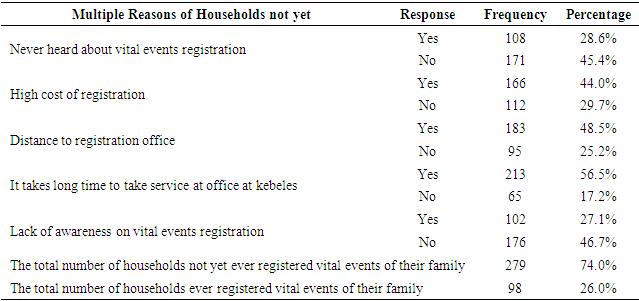 |
| |
|
 | Figure 3. Bar chart: Distribution of likelihood of households to use vital event registration in the future |
As discussed above, among the five possible reasons of respondents to stay without registration, the time invested at registration office is the major one (56.5% of respondents remain without registration because of the long time taken at kebeles to get registered). The following chart displayed respondents’ rate on average time taken to get vital event registration service at kebele offices. | Figure 4. Bar chart: Rating on the average time taken to get vital events registration service at kebeles |
Among the 98 (24%) of the total respondents who registered vital events of their family, 31.63% believe taken to get the service is too much, 59.18% of them believe that the time taken to get the service is moderate while only 9.18% of them believe that taken to get the service is fast.
4.5. Scoring on the Questionnaires
The knowledge of households towards vital event registration had 10 questions on general knowledge regarding the uses of vital event registration, 3 questions on knowledge of households towards the official time period to register vital events.The results of the analysis were presented in frequency distribution tables. For the 10 questions on knowledge regarding the uses of vital event registration, participants who had 0 to 3 correct answers out of the 10 were assumed to have poor knowledge about the uses of vital event registration. This score range of 0–3 was labeled as ‘poor knowledge’ in the frequency distribution table. Participants who had between 4 and 6 correct answers were assumed to have average knowledge about the uses of vital event registration and this score range of 4–6 was labeled as ‘average knowledge’. Participants with 7 to 10 correct answers were assumed to have good knowledge about the uses of vital event registration, with this score range of 7–10 being labeled as ‘good knowledge’ (Okonta HI et al., 2014).Similarly, for the 3 questions on knowledge of households towards the official time period to register vital events, zero, one and 2-3 correct answer were labeled as poor knowledge, average knowledge and good knowledge, respectively (Okonta HI et al., 2014).Table 8. Frequency Distribution of Households Knowledge Score on the uses of Vital Event Registration and Official time Period to Register Vital Events
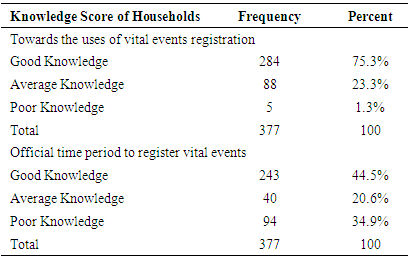 |
| |
|
Table 8 shows that 75.5% (n = 377) of the households participated in the study had good knowledge towards the uses of civil registration and vital events; 44.5% (n=377) had good knowledge about the official time period to register the vital events at the kebele level office.Attitude of Households towards the uses of Vital Events RegistrationFor the attitude of households towards the uses of vital event registration were observed through 7 positively affiliated questions on uses of vital events registration. The score of households attitude based on 7 positively affiliated questions that ranges below 20th, 20th-40th, 40th-60th, 60th-80th and above 80th percentiles were labeled as strongly positive, positive, neutral, negative and strongly negative attitude of households towards vital event registration (Okonta HI et al., 2014).Table 9. Frequency Distribution of Households on Uses of Attitude Score Vital Event Registration
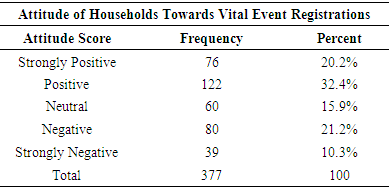 |
| |
|
As it depicted in the Table 9, the majority (n = 377, 32.4 %) of households in Hawassa city and surrounding districts had a positive towards the uses of attitude and about (n = 377, 21.2%) had a negative attitude towards the uses of vital event registration service provided from kebele to regional offices.Practice of Households on vital event registrationFor the practice of households on vital event registration were observed through 2 positively affiliated questions on how to use vital events registration in the future and previously. The score of households practice based on 2 positively affiliated questions 2, 3, 4, 5 and 6 were labeled as very good practice, good practice, poor practice and very poor practice on vital event registration (Okonta HI et al., 2014).Table 10. Frequency Distribution of Households Practice on Vital Events Registration
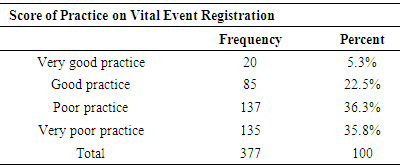 |
| |
|
The practices of households on the vital events registration, about (n=377, 22.5%) of households living in Hawassa city and surrounding had good practice on vital events registration whereas, about (n=377, 36.3%) had poor practices. As it can be depicted in the table, the distribution of households mainly had poor practices on vial events registration.The Correlation between Knowledge, Attitude and Practice Level on Vital Events RegistrationAs it can be shown in the Table 11, there is a positive correlation of 0.297 (p-value= 0.000) between the attitude of households on the advantage of vital events registration and the practice of households on vital event registration usage. Additionally, there is weak, positive correlation (r=0.011) between knowledge of households towards vital event registration and their practice. Moreover, there is no correlation between knowledge and attitude on vital event registration of households living in the study area.Table 11. Correlation of Knowledge, Attitude and Practice Level on Vital Events Registration
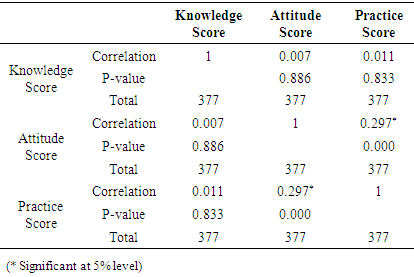 |
| |
|
5. Discussion
Birth registration is the official recording of the birth of a child through an administrative process of the State. It is both a fundamental human right and an essential means of protecting child’s right to identity. The United Nations general assembly resolution in 2002, titled “a world fit for children” reaffirms governments’ commitment to ensure the birth registration of all children and to invest in, care for, educate and protect children from harm and exploitation (UNICEF, 2005).Birth registration serves both a legal and statistical purpose for children within a given country. For legal purposes, birth registration is part of an effective civil registration system that legally acknowledges the existence of a person, entitles the child to a birth certificate, establishes the child’s family ties, and tracks major life events from live birth to marriage and death. The demographic data emerging from civil registration allows a country to keep track of its own population statistics, trends and differentials. The use of such data can lead to more accurate planning and implementation of development policies and programs, particularly in health, education, housing, water and sanitation, employment, agriculture and industrial production (Alphonsus et al., 2015).In this study, we assessed the level of awareness, knowledge and practice of respondents on vital events and civil registration. Among the respondents included in the survey, 24.6% of them had registered for vital events of their family. This result indicates there is improvement in vital registration particularly birth registration in Ethiopia compared with previous reports by Sonja et al., 2013, on which it is reported that the share of children younger than 5 years whose births were registered was 7%, 41%, 60% and 88% in Ethiopia, India, Kenya and Viet Nam, respectively.The study also revealed that the most common reasons for not being registered for vital events are the long time taken to take service at kebeles (56.5%), long distance to registration office (48.5%), high registration cost (44.0%), lack of awareness on vital events registration (27.1%) and lack of information on vital events registration (28.6%). The result agrees with a study in Ghana by (Sonja F. & Joyce O., 2013) on which the most common reasons for not registering a child were the high cost of registration (31.9%), distance to registration locations (21%) and a lack of awareness that children should be registered (20%).The World Bank introduced the concept for global investment in CRVS, and presented a global goal to achieve universal civil registration of births, deaths and other vital events and legal proof of registration by 2030 (CRVS, 2014). The vital event registration is not only a fundamental right of human being itself, but also a key to benefit the community at large in different aspects. As a result the findings of this study revealed that, households living in Hawassa city administration had high (75.3%) knowledge on the importance of vital event registration. This finding was consistent with study conducted by (Sara & Atimati, 2015) resulted the high awareness on birth registration in Nigeria. Moreover the study revealed that, about 44.5% of households had good knowledge on official time period to register vital event whereas, about 34.9% had poor knowledge. Thus, due to the reason that Ethiopia faces a number of challenges with regard to CRVS, including a large, mainly rural population, and highly decentralized administrative structures (CRVS, 2014). Most notably, more than 50% of households had positive attitude towards civil and vital event registration in Hawassa city and surrounding. When come to the practice of households on vital event registration the current study show that, about 70% had poor practice to register the vital event happened in their family. The difference between the practice of vital event registration among the respondents in this study (70%) and the level of knowledge on official time period to register vital event (44.5%) may be accounted for by the overall poor knowledge on civil and vital event registration that was contrary agreed with finding obtained by (Sara & Atimati, 2015), resulted the high awareness on birth registration in Nigeria.This further contradicts the fact that general knowledge on vital event registration is a major driving force behind the practice by a society. This may be the reason why majority of households in had poor and/or average knowledge on official time period to register their vital event at Kebele level office. Especially, it brings failure to register on time for new birth. But birth certificate is considered as the child’s right to name and nationality also empowers him/her to access other rights including health care, education and social assistance (UNICEF, 2010). It can also serve as an identity document which help protect children against early marriage, child labor, premature enlistment in the armed forces or, if accused of a crime, prosecution as an adult (UNICEF, 2010).Thus, the birth registration is considered as one of as a fundamental human right is often overlooked due to the continuing lack of awareness that registration is a critical measure to secure the recognition of any person before the law (NPC, 2008). Furthermore, the result of correlation specified that, there is a significant positive relation between household attitude and practice on vital event registration. This might be due to the reason that a number of challenges with regard to CRVS, including a large, mainly rural population, and highly decentralized administrative structures of Ethiopia (CRVS, 2014).
6. Conclusions and Recommendations
The study was conducted with the aim of assessing knowledge, attitude and practice of residents towards civil registration and vital statistics at Hawassa City Administration, Ethiopia. Among the respondents included in the survey, only 24.6% of them had registered for vital events of their family while 75.4% of them remain unregistered.The most common reasons for not being registered for vital events are long distance to registration office, high registration cost, lack of awareness on vital events registration and lack of information on vital events registration. Furthermore, there is a significant positive relation between household attitude and practice on vital event registration. Concerned government body should take in to account this gap and promote importance of vital events registration to the public.Considering individual and national level benefit of civil registration and vital statistics, we recommend more investment by the government to improve the registration as well as certification system at local and national level.Different communication Medias (Tv, Radio and Social Media) can be used as a tool to create awareness on the importance of civil registration and vital statistics and publicize about its benefit.Elementary schools are recommended to put birth certificate as a mandatory document for school enrolment so as to encourage birth registration and minimize the risk of a child being unregistered. Local churches, mosques and municipalities are recommended to request death certificate as a supporting document for provision of burial permits and legal claims so as to play their role in encouraging and promoting death registration.
References
| [1] | ACS& ECA (2017). Practical guide on improvement of death registration and cause of death processes within a Civil Registration and Vital Statistics System: African Centre for statistics (ACS) & Economic Commission for Africa (ECA): Third Draft, October 2017. |
| [2] | Adedini S. A and Odimegwu C. O. (2011). Assessing Knowledge, Attitude And Practice Of Vital Registration System In South-West Nigeria: Ife Psychologia; Volume 19, Number 1, March 2011. |
| [3] | African Child Policy Forum (2005). Perception and Practice: Review of Birth Registration in Addis Ababa and the Regional States of Oromia, Amhara and SNNPR, Ethiopia. |
| [4] | Alphonsus R. Isara, Antony O. Atimati1 (2015). Sociodemographic determinants of birth registration among mothers in an urban community in southern Nigeria: Journal of Medicine in the Tropics (2015) 17:1:16-21. |
| [5] | Cochran, W (1977): Sampling Techniques, 3rd edition. New York: Wiley Series in Probability and Statistics. |
| [6] | CRVS (2014). Civil Registration and Vital Statistics Investment Planning: Report of A Technical Consultation, Addis Ababa, 28-29 April 2014. |
| [7] | CSA (2013). Towards sustainable vital events registration and vital statistics systems of Ethiopia: Strategy and Action Plan July 2013 – June 2018; Central Statistical Agency, Addis Ababa, Ethiopia. |
| [8] | CSA (2012). 2007 Population and Housing Census of Ethiopia: Administrative Report; Central Statistical Authority 2012, Addis Ababa, Ethiopia. |
| [9] | Federal Negarit Gazeta (2012). Federal Negarit Gazeta of the Federal Democratic Government of Ethiopia: Registration of Vital Events and National Identity Card Proclamation No. 760/2012, Federal Negarit Gazeta, 18th Year No.58, Addis Ababa, 22nd August 2012. Page 6499. |
| [10] | Imperial Ethiopian Government (1960). Civil Code of the Empire of Ethiopia. Negarit Gazeta. Negarit Gazeta, 19th Year No.2, Addis Ababa, 5 May 1960. |
| [11] | Mbuvi B. (2003). “Country presentation on Vital Registration in Kenya,” paper presented at WHO workshop on ‘Minimum data set version 1.0 on ageing and adult mortality data in sub-Saharan Africa’. Pretoria, South Africa, 12-14 Feb, 2003. |
| [12] | Mills, S., Lee, J.K. & Rassekh, B.M (2019). An introduction to the civil registration and vital statistics systems with applications in low- and middle-income countries. J Health Popul Nutr 38, 23 (2019). https://doi.org/10.1186/s41043-019-0177-1. |
| [13] | NPC (2008). National Population Commission: Reports on Live Births, Deaths and Still Births Registration in Nigeria (19942007). Abuja: NPopC; 2008. |
| [14] | Okonta HI, Ikombele JB, Ogunbanjo GA. (2014). Knowledge, attitude and practice regarding lifestyle modification in type 2 diabetes patients. African Journal of Primary Health Care and Family Medicine. |
| [15] | R. Rampatige, L. Mikkelsen, B. Hernandez and I. Riley (2014): Systematic review of statistics on causes of deaths in hospitals: strengthening the evidence for policy-makers: Bulletin of the World Health Organization (2014); http://dx.doi.org/10.2471/BLT.14.137935. |
| [16] | Sara and Atimati (2015). Sociodemographic determinants of birth registration. Journal of Medicine in the Tropics (2015) 17: 1: 16-21. |
| [17] | Sonja Fagernas and Joyce Odam (2013). Birth registration and access to health care: an assessment of Ghana’s campaign success: Bull World Health Organ 2013; 91: 459–464. |
| [18] | T. G. Birru (2007). Gender Statistics and the Status of Civil Registration and Vital Statistics in Ethiopia. Global Forum on Gender Statistics: December 10-17, 2007: Rome, Italy. |
| [19] | The Revised Family Code Proclamation (2000). Proclamation No.213/2000. Ordinary Issue No. 1/2000. 6th year. Addis Ababa. 4th Day of July 2000. |
| [20] | UN (2001). Principles and Recommendations for a Vital Statistics System Revision 2. Sales No. E. 01. XVII.10, United Nations, New York. |
| [21] | UN (1998). Handbook on Civil Registration and Vital Statistics Systems: Management, Operation and Maintenance, Sales No. E.98. XVII.11, United Nations, New York. |
| [22] | UNECA (2014). Making Every One Visible: Why Improving Civil Registration and Vital Statistics in Africa is Important. Addis Ababa: United Nations Economic Commission for Africa; 2014. |
| [23] | UNICEF (2013). Every Child’s Birth Right: Inequities and trends in birth registration, UNICEF, New York, 2013. |
| [24] | UNICEF (2010). United Nations Children Nigeria Funds Fact Sheet: Birth Registration in Nigeria. New York. UNICEF; 2010. |
| [25] | UNICEF (2005). United Nations Children Funds. The “Rights” Start to Life: A Statistical Analysis of Birth Registration. NewYork. UNICEF; 2005. |
| [26] | U.S. Bureau of the Census (1971). The Methods and Materials of Demography by Henry S. Shryock, Jacob S. Siegel and Associates: U.S Government Printing Office, Washington, D.C, 1971. |
| [27] | WHO (2018). The Future for Women and Children: UNICEF and WHO Joint Statement on Strengthening Civil Registration and Vital Statistics. |
| [28] | WHO (2014). Civil registration: why counting births and deaths is important: Geneva: World Health Organization, 2014. |
| [29] | WHO (2013). Civil Registration and Vital Statistics: challenges, best practice and design principles for modern systems. Geneva: World Health Organization; 2013. |
| [30] | WHO (2004). Maternal Mortality Estimates developed by WHO, UNICEF and UNFPA. Geneva, World Health Organization, 2004. |
| [31] | Yang G. H., Zheng X. W. and Zeng G (1992). ” Selection of DSP Points in second stage and their presentation”, Chinese journal of Epidemology 13(4): 197-201. |





 Z=1.96 for a 95% level of confidence, or 2.56 for a 99% level of confidence and d is maximum allowable (margin) error and h is the number of cluster of Hawassa city and surrounding districts. The specified variance of the estimate and in case of estimating proportion, the stratum variance is given by for common p (proportion of households having enough knowledge of civil registration and vital events). In the most case, the proportion of success is given as (p=0.5) that can be used in different literature to determine the sample size. The reason that the study used common p for all cluster was that all civil registration and vital event registration is provided at kebeles of Hawassa city and its surrounding districts was homogenous.Sampling WeightsDue to the non-proportional allocation of the sample to different clusters in Hawassa city administration with possible differences in response rates, a sampling weight must be used in all analyses using the data to ensure the actual representative of the survey. Since the single stage stratified cluster sample, sampling weights are based on sampling probabilities each cluster.The study used the following notations:
Z=1.96 for a 95% level of confidence, or 2.56 for a 99% level of confidence and d is maximum allowable (margin) error and h is the number of cluster of Hawassa city and surrounding districts. The specified variance of the estimate and in case of estimating proportion, the stratum variance is given by for common p (proportion of households having enough knowledge of civil registration and vital events). In the most case, the proportion of success is given as (p=0.5) that can be used in different literature to determine the sample size. The reason that the study used common p for all cluster was that all civil registration and vital event registration is provided at kebeles of Hawassa city and its surrounding districts was homogenous.Sampling WeightsDue to the non-proportional allocation of the sample to different clusters in Hawassa city administration with possible differences in response rates, a sampling weight must be used in all analyses using the data to ensure the actual representative of the survey. Since the single stage stratified cluster sample, sampling weights are based on sampling probabilities each cluster.The study used the following notations:
 , is the sample weight for hth stratum
, is the sample weight for hth stratum  is the number of households in hth strata and N is the total number of households at the study area. Table 1 below depicts the values of number of households in each stratum and their corresponding sample weight based on 2007 population and housing census of Ethiopia (CSA, 2012).
is the number of households in hth strata and N is the total number of households at the study area. Table 1 below depicts the values of number of households in each stratum and their corresponding sample weight based on 2007 population and housing census of Ethiopia (CSA, 2012). 



 Abstract
Abstract Reference
Reference Full-Text PDF
Full-Text PDF Full-text HTML
Full-text HTML









